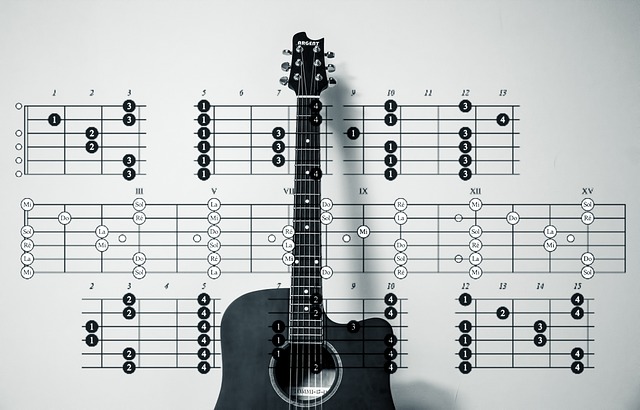Open chords are the basis of many songs and styles of guitar playing. Mastering these chords is crucial for beginners because they provide the foundation for countless songs and allow you to start playing music in no time. In this chapter, we’ll cover the six basic open chords (C, G, D, E, A, and F) as well as proper finger placement and strumming techniques.
1. Basic open chords
C major:
Place your ring finger on the third fret of the fifth (A) string.
Leave the other strings open.
G major:
Place your index finger on the second fret of the fifth (A) string.
Place your middle finger on the 3rd fret of the 6th (low E) string.
Leave the other strings open.
D major:
Place your index finger on the second fret of the third (G) string.
Place your middle finger on the second fret of the first (high E) string.
Place your ring finger on the third fret of the second (B) string.
Leave the other strings open.
E major:
Place your index finger on the 1st fret of the 3rd (G) string.
Place your middle finger on the second fret of the fifth (A) string.
Place your ring finger on the 2nd fret of the 4th (D) string.
Leave the other strings open.
Main:
Place your index finger on the second fret of the fourth (D) string.
Place your middle finger on the 2nd fret of the 3rd (G) string.
Place your ring finger on the second fret of the second (B) string.
Leave the other strings open.
F major:
Place your index finger on the first fret of the second (B) string.
Place your middle finger on the 2nd fret of the 3rd (G) string.
Place your ring finger on the third fret of the fourth (D) string.
Leave the other strings open.
2. Finger placement techniques
Put your fingers close to the frets for a clear and clean sound.
Press down on the strings with your fingertips to avoid muting adjacent strings.
Maintain a relaxed hand position and arch your fingers to avoid accidental muting.
3. Strumming skills
Strum Down: Using a pick, strum down from the 6th (low E) string to the 1st (high E) string. Keep your wrists relaxed for smooth movements.
Upward strum: Strum up from the 1st (high E) string to the 6th (low E) string. Again, keep your wrists relaxed.
Down Strum: Combine down and up strums to create a continuous strum pattern. Start by strumming down, then strum up.
4. Strum Mode
Experiment with various strumming patterns to add rhythm and dynamics to your playing. For example:
down, down, up, up, down
down, up, down, up
Mastering basic open chord and strumming techniques is an important step in becoming a confident guitarist. Practice smooth transitions between these chords and experiment with different strumming patterns. As you progress, you’ll discover the joys of playing your favourite songs, and even create your own music using these fundamental skills. Remember that consistent practice and patience will make your guitar journey proficient and enjoyable.








